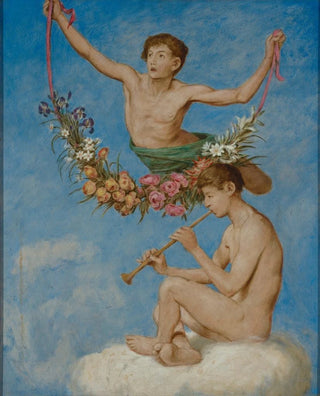Art print | Que deux jeunes génies avec des fleurs - Hans Thoma


View from behind

Frame (optional)
In the vibrant universe of art, some works manage to capture the very essence of youth and beauty. "Que deux jeunes génies avec des fleurs" by Hans Thoma is undoubtedly one of these creations. This piece, imbued with delicacy and freshness, evokes a suspended moment where nature and humanity meet. Through this art print, the viewer is invited to explore a world where the innocence of young minds blends with the splendor of flowers, symbols of life and renewal. Thoma, through his undeniable talent, succeeds in transporting us to a reality where dreams and nature intertwine, offering an unforgettable visual experience.
Style and uniqueness of the work
Hans Thoma's style is distinguished by his ability to blend tradition and modernity, while maintaining a deeply human sensitivity. In "Que deux jeunes génies avec des fleurs," the artist uses vibrant colors and gentle forms to create an atmosphere of lightness. The young figures, delicately depicted, seem almost to float in a lush garden, surrounded by radiant flowers that breathe joy of life. The meticulous details of the petals and foliage testify to attentive observation of nature, while the expressions of the young protagonists evoke insatiable curiosity and the carefree innocence characteristic of childhood. This work stands out for its ability to evoke deep emotions through a visual language that is both simple and poetic.
The artist and his influence
Hans Thoma, born in 1839 in Germany, is an emblematic figure of the 19th-century artistic movement. His career, marked by an incessant quest for harmony between man and nature, led him to explore various styles and techniques. Influenced by Romanticism and Realism, Thoma developed a unique style that allowed him to express his vision of the world with a singular sensitivity. His work is often infused with folkloric and mythological references, reflecting a deep respect for cultural traditions. Through "Que deux jeunes génies avec des fleurs," he invites the viewer to

Matte finish

View from behind

Frame (optional)
In the vibrant universe of art, some works manage to capture the very essence of youth and beauty. "Que deux jeunes génies avec des fleurs" by Hans Thoma is undoubtedly one of these creations. This piece, imbued with delicacy and freshness, evokes a suspended moment where nature and humanity meet. Through this art print, the viewer is invited to explore a world where the innocence of young minds blends with the splendor of flowers, symbols of life and renewal. Thoma, through his undeniable talent, succeeds in transporting us to a reality where dreams and nature intertwine, offering an unforgettable visual experience.
Style and uniqueness of the work
Hans Thoma's style is distinguished by his ability to blend tradition and modernity, while maintaining a deeply human sensitivity. In "Que deux jeunes génies avec des fleurs," the artist uses vibrant colors and gentle forms to create an atmosphere of lightness. The young figures, delicately depicted, seem almost to float in a lush garden, surrounded by radiant flowers that breathe joy of life. The meticulous details of the petals and foliage testify to attentive observation of nature, while the expressions of the young protagonists evoke insatiable curiosity and the carefree innocence characteristic of childhood. This work stands out for its ability to evoke deep emotions through a visual language that is both simple and poetic.
The artist and his influence
Hans Thoma, born in 1839 in Germany, is an emblematic figure of the 19th-century artistic movement. His career, marked by an incessant quest for harmony between man and nature, led him to explore various styles and techniques. Influenced by Romanticism and Realism, Thoma developed a unique style that allowed him to express his vision of the world with a singular sensitivity. His work is often infused with folkloric and mythological references, reflecting a deep respect for cultural traditions. Through "Que deux jeunes génies avec des fleurs," he invites the viewer to






